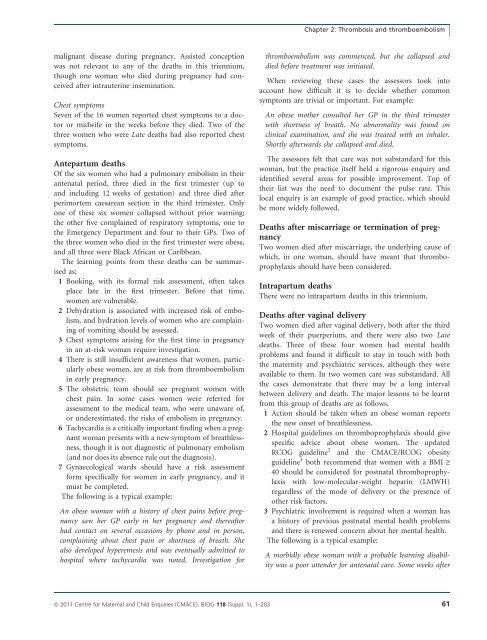6.-March-2011-Saving-Mothers-Lives-reviewing-maternal-deaths-to-make-motherhood-safer-2006-2008
6.-March-2011-Saving-Mothers-Lives-reviewing-maternal-deaths-to-make-motherhood-safer-2006-2008
6.-March-2011-Saving-Mothers-Lives-reviewing-maternal-deaths-to-make-motherhood-safer-2006-2008
Create successful ePaper yourself
Turn your PDF publications into a flip-book with our unique Google optimized e-Paper software.
Chapter 2: Thrombosis and thromboembolismmalignant disease during pregnancy. Assisted conceptionwas not relevant <strong>to</strong> any of the <strong>deaths</strong> in this triennium,though one woman who died during pregnancy had conceivedafter intrauterine insemination.Chest symp<strong>to</strong>msSeven of the 16 women reported chest symp<strong>to</strong>ms <strong>to</strong> a doc<strong>to</strong>ror midwife in the weeks before they died. Two of thethree women who were Late <strong>deaths</strong> had also reported chestsymp<strong>to</strong>ms.Antepartum <strong>deaths</strong>Of the six women who had a pulmonary embolism in theirantenatal period, three died in the first trimester (up <strong>to</strong>and including 12 weeks of gestation) and three died afterperimortem caesarean section in the third trimester. Onlyone of these six women collapsed without prior warning;the other five complained of respira<strong>to</strong>ry symp<strong>to</strong>ms, one <strong>to</strong>the Emergency Department and four <strong>to</strong> their GPs. Two ofthe three women who died in the first trimester were obese,and all three were Black African or Caribbean.The learning points from these <strong>deaths</strong> can be summarisedas:1 Booking, with its formal risk assessment, often takesplace late in the first trimester. Before that time,women are vulnerable.2 Dehydration is associated with increased risk of embolism,and hydration levels of women who are complainingof vomiting should be assessed.3 Chest symp<strong>to</strong>ms arising for the first time in pregnancyin an at-risk woman require investigation.4 There is still insufficient awareness that women, particularlyobese women, are at risk from thromboembolismin early pregnancy.5 The obstetric team should see pregnant women withchest pain. In some cases women were referred forassessment <strong>to</strong> the medical team, who were unaware of,or underestimated, the risks of embolism in pregnancy.6 Tachycardia is a critically important finding when a pregnantwoman presents with a new symp<strong>to</strong>m of breathlessness,though it is not diagnostic of pulmonary embolism(and nor does its absence rule out the diagnosis).7 Gynaecological wards should have a risk assessmentform specifically for women in early pregnancy, and itmust be completed.The following is a typical example:An obese woman with a his<strong>to</strong>ry of chest pains before pregnancysaw her GP early in her pregnancy and thereafterhad contact on several occasions by phone and in person,complaining about chest pain or shortness of breath. Shealso developed hyperemesis and was eventually admitted <strong>to</strong>hospital where tachycardia was noted. Investigation forthromboembolism was commenced, but she collapsed anddied before treatment was initiated.When <strong>reviewing</strong> these cases the assessors <strong>to</strong>ok in<strong>to</strong>account how difficult it is <strong>to</strong> decide whether commonsymp<strong>to</strong>ms are trivial or important. For example:An obese mother consulted her GP in the third trimesterwith shortness of breath. No abnormality was found onclinical examination, and she was treated with an inhaler.Shortly afterwards she collapsed and died.The assessors felt that care was not substandard for thiswoman, but the practice itself held a rigorous enquiry andidentified several areas for possible improvement. Top oftheir list was the need <strong>to</strong> document the pulse rate. Thislocal enquiry is an example of good practice, which shouldbe more widely followed.Deaths after miscarriage or termination of pregnancyTwo women died after miscarriage, the underlying cause ofwhich, in one woman, should have meant that thromboprophylaxisshould have been considered.Intrapartum <strong>deaths</strong>There were no intrapartum <strong>deaths</strong> in this triennium.Deaths after vaginal deliveryTwo women died after vaginal delivery, both after the thirdweek of their puerperium, and there were also two Late<strong>deaths</strong>. Three of these four women had mental healthproblems and found it difficult <strong>to</strong> stay in <strong>to</strong>uch with boththe maternity and psychiatric services, although they wereavailable <strong>to</strong> them. In two women care was substandard. Allthe cases demonstrate that there may be a long intervalbetween delivery and death. The major lessons <strong>to</strong> be learntfrom this group of <strong>deaths</strong> are as follows.1 Action should be taken when an obese woman reportsthe new onset of breathlessness.2 Hospital guidelines on thromboprophylaxis should givespecific advice about obese women. The updatedRCOG guideline 2 and the CMACE/RCOG obesityguideline 1 both recommend that women with a BMI ‡40 should be considered for postnatal thromboprophylaxiswith low-molecular-weight heparin (LMWH)regardless of the mode of delivery or the presence ofother risk fac<strong>to</strong>rs.3 Psychiatric involvement is required when a woman hasa his<strong>to</strong>ry of previous postnatal mental health problemsand there is renewed concern about her mental health.The following is a typical example:A morbidly obese woman with a probable learning disabilitywas a poor attender for antenatal care. Some weeks afterª <strong>2011</strong> Centre for Maternal and Child Enquiries (CMACE), BJOG 118 (Suppl. 1), 1–203 61


